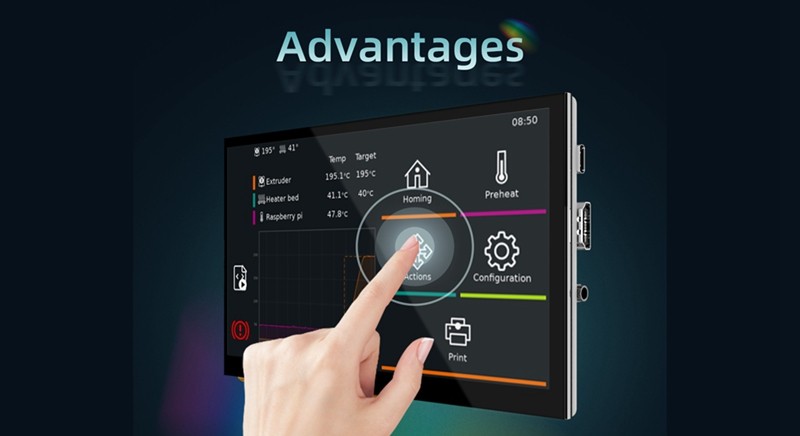In the fast-paced world of technology, touch-enabled LCD displays have emerged as a transformative innovation, revolutionizing the way we interact with digital content. At XIANHENG TECH, with over a decade of professional expertise in providing cutting-edge LCD solutions, we understand the significance of touch-enabled displays in today's digital landscape. In this article, we delve into the world of touch-enabled LCDs, exploring their capabilities, applications, and the advantages they offer to
In the fast-paced world of technology, touch-enabled LCD displays have emerged as a transformative innovation, revolutionizing the way we interact with digital content. At
XIANHENG TECH, with over a decade of professional expertise in providing cutting-edge LCD solutions, we understand the significance of touch-enabled displays in today's digital landscape. In this article, we delve into the world of touch-enabled LCDs, exploring their capabilities, applications, and the advantages they offer to various industries.

Understanding Touch-Enabled LCD Displays
What Are Touch-Enabled LCD Displays?
Touch-enabled LCD displays, also known as touchscreen displays, combine the visual excellence of LCD technology with the interactivity of touch-sensitive screens. These displays incorporate a layer of touch-sensitive material that allows users to interact directly with the screen using their fingers or stylus, eliminating the need for external input devices like mice or keyboards.
The Versatility of Touch-Enabled LCDs
Applications Across Industries
Touch-enabled LCD displays have found applications across a wide range of industries, transforming the way businesses and individuals engage with technology:
Retail: In the retail sector, touch-enabled displays are used for interactive kiosks, point-of-sale systems, and digital signage, providing customers with a seamless and engaging shopping experience.
Healthcare: Hospitals and healthcare facilities benefit from touch-enabled displays in electronic health records (EHR) systems, medical imaging, and patient information kiosks, improving efficiency and patient care.
Education: Touchscreens have revolutionized the classroom by enhancing interactive learning experiences through interactive whiteboards, tablets, and educational applications.
Gaming: The gaming industry has embraced touch-enabled displays in smartphones, tablets, and gaming consoles, offering immersive gameplay and intuitive controls.
Manufacturing: In manufacturing environments, touchscreen displays are used for process control, monitoring, and quality assurance, streamlining operations and increasing productivity.
Advantages of Touch-Enabled LCD Displays
Why Choose Touch-Enabled Displays?
The adoption of touch-enabled LCD displays brings forth several advantages that contribute to their growing popularity:
Intuitive Interaction: Touchscreens offer a natural and intuitive way to interact with digital content, making them accessible to users of all ages and technical backgrounds.
Space Efficiency: Touch-enabled displays eliminate the need for external input devices, saving valuable workspace and reducing clutter.
Enhanced Engagement: Touchscreens enhance user engagement and interactivity, making them ideal for presentations, marketing, and customer interactions.
Durability: Many touch-enabled displays are designed with durability in mind, featuring scratch-resistant surfaces and robust construction to withstand heavy use.
Multitouch Capability: Modern touchscreens support multitouch gestures, allowing for pinch-to-zoom, swiping, and other multi-finger interactions, similar to popular mobile devices.
The Future of Touch-Enabled Displays
Advancements and Trends
As technology continues to evolve, touch-enabled LCD displays are poised for further advancements. Some notable trends and developments in the field include:
Flexible Displays: The emergence of flexible OLED and LCD technologies is paving the way for curved and flexible touch-enabled displays, offering new possibilities for design and form factor.
Haptic Feedback: Innovations in haptic feedback technology are enhancing the tactile experience of touchscreens, providing users with a sense of touch and realism.
Integration with AI: Integration with artificial intelligence (AI) and voice recognition is making touch-enabled displays even more versatile, enabling seamless voice and touch interactions.
Increased Use in Automotive: Touch-enabled displays are becoming ubiquitous in automotive design, with interactive infotainment systems, heads-up displays, and digital instrument clusters enhancing the driving experience.
Conclusion
In a world where digital interactions are increasingly prevalent, touch-enabled LCD displays stand at the forefront of innovation. Their versatility, intuitive usability, and ever-evolving capabilities make them a vital component in various industries, driving efficiency, engagement, and user satisfaction. At XIANHENG TECH, we remain committed to delivering state-of-the-art LCD solutions, including touch-enabled displays, to meet the evolving needs of our clients and partners.

FAQs about Touch-Enabled LCD Displays
Q1: What industries can benefit from touch-enabled LCD displays?
Touch-enabled LCD displays find applications in retail, healthcare, education, gaming, manufacturing, and many other industries, enhancing interactivity and efficiency.
Q2: Are touch-enabled displays durable?
Many touch-enabled displays are designed to be durable, featuring scratch-resistant surfaces and robust construction to withstand heavy use.
Q3: How do touch-enabled displays work?
Touch-enabled displays incorporate a touch-sensitive layer that detects touch inputs, allowing users to interact directly with the screen using their fingers or a stylus.
Q4: Can touch-enabled displays support multitouch gestures?
Yes, modern touch-enabled displays support multitouch gestures, enabling users to perform actions like pinch-to-zoom and swiping with multiple fingers.
Q5: What are some future trends in touch-enabled displays?
Future trends include flexible displays, haptic feedback technology, integration with AI and voice recognition, and increased use in automotive design.

